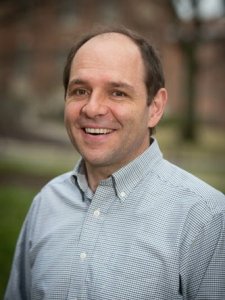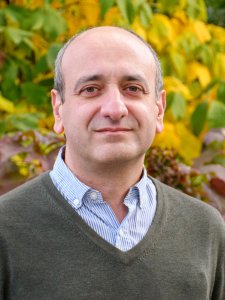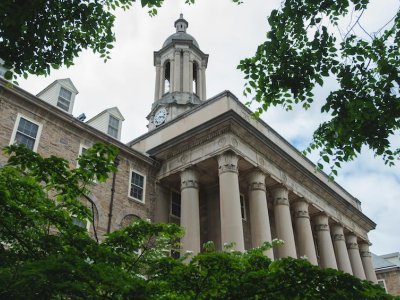25-minute listen/watch | 16-minute read | 1-minute teaser
Nitrous oxide is a potent greenhouse gas with nearly 300 times the warming potential of carbon dioxide, making even small emissions highly impactful. Agriculture, particularly soil management, is the largest source of nitrous oxide. To better understand and manage these emissions, researchers have developed a system for continuous monitoring on farms and other land management purposes.
Transcript
Felipe Montes
The problem with nitrous oxide emissions is that they are created by microorganisms in the soil, and they vary a lot. It's very difficult to determine where those emissions are occurring and when.
Host
Welcome to Growing Impact, a podcast by the Institute of Energy and Environment at Penn State. Each month, Growing Impact explores the projects of Penn State researchers who are solving some of the world's most challenging energy and environmental issues. Each project has been funded by the Institute's seed grant program that grows new research ideas into impactful energy and environmental solutions.
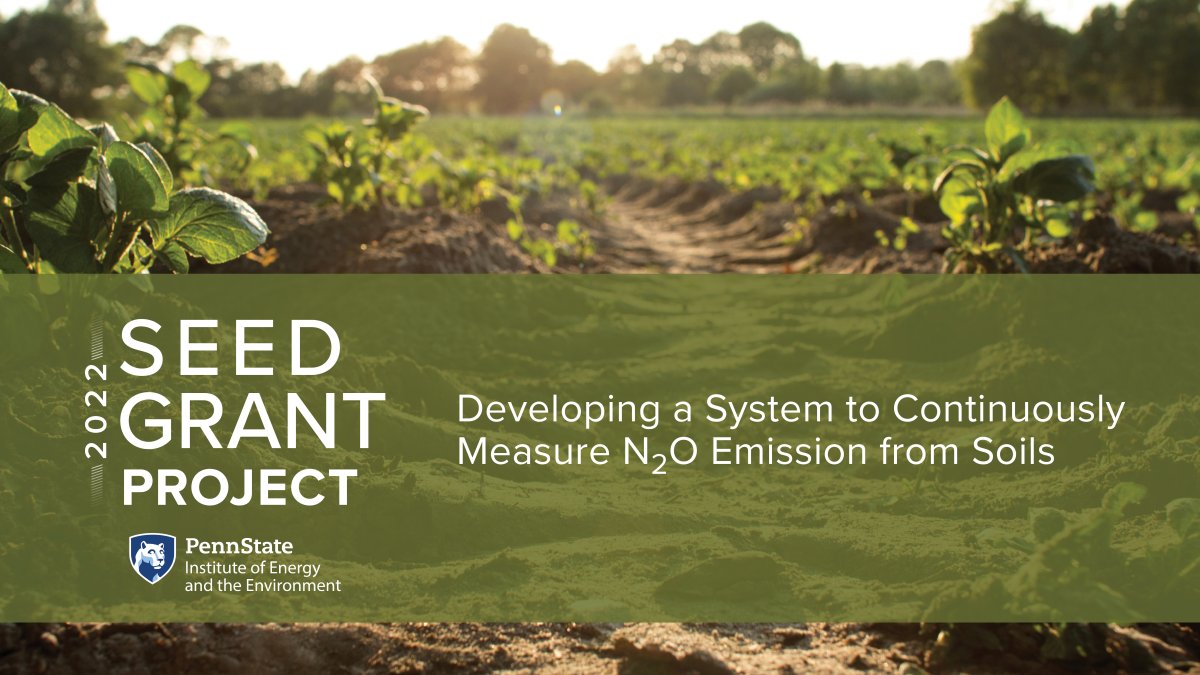
I'm your host, Kevin Sliman. Nitrous oxide is a potent greenhouse gas. Although it accounts for only 6% of greenhouse gas emissions from human activities, its warming potential is nearly 300 times that of carbon dioxide, meaning even small amounts can have a big effect on the climate.
Nitrous oxide comes from multiple sources, but one of the largest is the agricultural sector. In fact, agricultural soil management was the largest source of nitrous oxide emissions in 2022. This includes the application of fertilizers and manure management. Nitrous oxide emissions also occur naturally as a part of the nitrogen cycle, a vital process that sustains life by recycling nitrogen between the atmosphere and living organisms in the soil. However, this process is irregular and difficult to predict.
To better detect nitrous oxide emissions, a team of researchers has developed an innovative system capable of continuously monitoring nitrous oxide emissions on farms and beyond. Welcome, Felipe, Estelle, Armen, thank you so much for being on Growing Impact today.
Felipe Montes
Hello, Kevin.
Armen Kemanian
Hey, Kevin.
Host
This is a seed grant that is from a few years back and that has grown and seen a lot of success. So before we get into the research, can you introduce yourself, provide your name, title, and a brief background on your research?
Felipe Montes
Sure. Thank you for having me. It's a pleasure. I'm Felipe Montes. I'm an associate research professor in the College of Ag, in the Plant Science Department, and I work in the Agroecosystems Modeling Laboratory, which is directed by Professor Armen Kemanian. I'm interested in measuring, understanding, and modeling processes in the environment, specifically in the agroecosystems environment.

Armen Kemanian
So my name is Armen Kemanian. I am a professor in the Department of Plant Science. My work involves soil, plants, hydrology, and I have particular expertise in modeling. And, you know, what pertains to this instance, I have been working on what we call climate-friendly farming since the early 2000s.
Estelle Couradeau
My name is Estelle Couradeau. I am an assistant professor in the Department of Ecosystem Science and Management in the College of Ag, and I'm also a Huck co-hire. I started my lab in 2020, and my lab focuses on the study of soil microbiomes, so the communities of microbes that are in the soil. We are very interested in learning which microbes are active, what they are doing, and how those functions might change with climate change. And if we could leverage this function to help with climate resiliency.
Host
So, let's discuss the background of this project. So your project focuses on emissions from soil, namely nitrous oxide. Can you discuss the impact of nitrous oxide on climate change and explain the science of soil emissions?
Felipe Montes
Nitrous oxide is a greenhouse gas. So it contributes to global warming and climate change. The concentration in the atmosphere is very low. It's about one millionth of what CO2 is, the concentration of CO2 is. But nitrous oxide has the capacity to affect global warming almost 300 times more than CO2. My point is, if we put one part or one unit of CO2 there, and we put one unit of nitrous oxide there, the global warming effect will be 300 times for nitrous oxide that the global warming that CO2 will produce.
Now, most nitrous oxide emissions come from soils, specifically from agricultural soils, some of them from wastewater treatment plants and some from swamps and sediments that have drying and wetting spells. But most of the nitrous oxide emissions come from agricultural systems and soils in particular.
Host
Why is soil emitting nitrous oxide?
Armen Kemanian
So the atmosphere is essentially almost 80% nitrogen. Nitrogen is very inert. Some of that nitrogen is reduced to organic forms mostly by microorganisms. And also, you know, we do it as humans, you know, through the Haber-Bosch process, you know, when we produce fertilizers. And then they make it into the soil as a mineral. And in the cycling, as some of the nitrogen goes to nitrate, is a form of nitrogen or ammonia.
And, you know, we are going to go through the details through the conversation, but during that cycling, part of the nitrogen that is moving through that wheel will be emitted as nitrous oxide. That happens in the soil. There are soil microorganisms that essentially, in the process of moving nitrogen from one form to another, leak a little bit of that nitrogen, nitrous oxide.
And as Felipe mentioned, it's actually very little, you know, is the proverbial wicked problem, very little nitrogen that goes in that direction with a very high effect on global warming and agriculture, essentially, you know, let's say credited with about 80% of the emissions of nitrous oxide globally.
Estelle Couradeau
With the fact that, you know, it's those microbes who move the nitrogen pool. And so through a process that is called nitrification, so going from that nitrate. But we want that to go all the way back to N2 in the atmosphere. The fact is in agriculture we sometimes create conditions for those microbes to do this process, not complete... like in an incomplete way. So that instead of going all the way back to complete the nitrification and N2, they end up leaking N2O in the middle, and then this is when it's problematic. So thinking about, you know, what are the conditions that, enable microbes to do a complete nitrification versus incomplete and how we manage soil and what kind of nitrogen and carbon, so they use all those things are important for us to manage nitrous oxide.
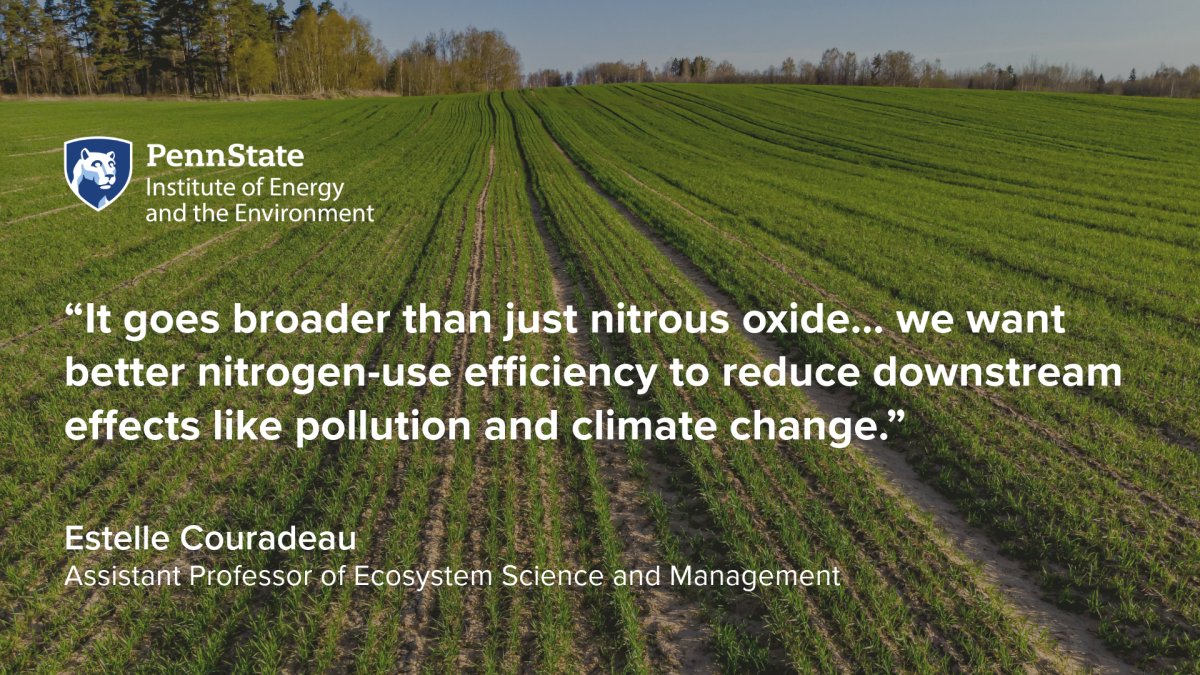
Host
In your original abstract, you said that our understanding and quantification of global soil nitrous oxide emissions, and the underlying processes controlling them, remain largely uncertain. Could you talk about what your project is doing to help fill in that knowledge gap?
Felipe Montes
Well, the problem with nitrous oxide emissions is, like Estelle said and Armen, too, is that they are created by microorganisms in the soil, and they vary a lot. Not only when they occur but where they occur. It's very difficult to determine where those emissions are occurring and when. So our project was funded to prototype and build and design a nitrous oxide emission system that will allow us to measure very frequent with a lot of resolution in time, nitrous oxide emissions, both in the lab and in the field.
And with that, we can start connecting the microbial part of the process, which is Estelle’s expertise, and use that to produce equations, that are quantifying processes that we can add to models, which is the expertise of Professor Kemanian. So our main focus is on the measurement part. Those measurements can help both the microbial part, the model part, and the interaction of those.
Lauren, professor McPhillips, helped us. First we use her instrument in the laboratory, the gas chromatograph, to start measuring nitrous oxide. And then she applies all her knowledge in urban systems and suburban systems. So the idea was also to use the prototype to apply it in those kind of systems with outside of what we usually working in agriculture.
Estelle Couradeau
So we have a hard time getting a predictive insight into when the nitrous oxide is going to be produced and how much, because it usually comes out as spikes from the soil. So it's like you create the perfect conditions for the microbes to do the nitrification, but not long enough, and at some point it just comes out.
So it makes it very difficult to measure in the field because you never know how much surface you need to average over to get a good representation of your field, and also how much time you need to average over. So it's make it like this idea of like this microbe working in hotspots and hot moments to produce the nitrous oxide makes it very hard for us to measure and therefore to make good models for the prediction. I think that was one of the points of that proposal to try to get like a measurement tool, like a prototype tool that would allow us to get better resolution in time and space for nitrous oxide production.
Armen Kemanian
There is one thing in biology I always said, you know, if you are a quarterback and you're going to throw the football, and if we know the angle that ball is taking and the force with which it is pushed, we can predict exactly where that ball will fall, right? We know. We are not there with nitrous oxide. Even we know how it is generated. We know what conditions favor it. There is enough variation in the soil that essentially when we throw that football and it falls somewhere. Right. And then we know directionally, you know, we know what conditions will increase emissions, but how much?

And maybe we can give an example to make it clear, you know, for the listeners in this case, it's a one instance we where we decided to measure nitrous oxide emissions in a farm. This was in Italy. That was very sandy. And predictions will be that, well, sandy conditions, they are well-drained. When the soil is well-drained and the air can move freely through it, emissions tend to be very low because usually the nitrification that causes the spikes requires that oxygen goes low, not to zero, but low. And we said, well, let's see what we measure.
And to give an idea, if one gets 5 pounds per acre of nitrous oxide in a year, in a full year, emitted that's a relatively large emission. Well, we measured 25 pounds in that case, in three weeks. So that's what I mean by sometimes we are kind of shocked by what we measure. And where did that come from?
Well, that project helped us understand that there are conditions that we didn't fully mature before, even though we knew that could actually trigger, you know, these spikes and brings back the idea of that we really need to be measuring this thing to understand it better. And the idea of having sensors that will let us continuously monitor the emissions from a soil will actually let us, you know, tame our understanding of this process more.
Host
Yeah. So that's really one of the keys to this. Right. So it's the continuous monitoring to help provide clarity as to when these occur or how these occur.
Armen Kemanian
There is also the technical aspect of measuring, I guess, that is at a very low concentration and has a structure, you know that gets easily confused with other gases. So therefore this, this sensing instrumentation is a challenge.
Host
So your equipment has to be ultra-sensitive to the nitrous oxide.
Felipe Montes
If you don't catch the emissions they are there and you don't know that they happen. So they could be happening a lot or in very low quantities. And you wouldn't know until the global warming effect comes. And that's why it is very difficult to predict, to manage, and to monitor.
Host
So, in this case, the continuous monitoring is an area where you're helping fill that need.
Felipe Montes
Exactly.
Armen Kemanian
There is this scientific interest in understanding the nitrogen cycle and the nitrogen balance, in particular the nitrous oxide balance in the atmosphere, meaning how much we put in, how much is reduced back. But then there is also an ever-growing commercial interest in that, you know, through the commercialization of carbon credits. So nitrogen can be turned into a carbon credit equivalent, you know, carbon dioxide equivalent, for commercialization.
And this business, which is a budding business, you know, it's not fully fledged yet. Markets are developing; knowing how much are you reducing in emission is very important, is actually all. And the value of the credit relates to the accuracy with which you can make a claim. And once again, measurements become critical. Right. And you know, we use a simple model, which is what we call an emission factor.
Or we can use a more complicated model that, you know, tries to run what's happened with the biogeochemistry of nitrogen and, or we can have measurements. And measurements command a much higher, you know, measure reductions in emissions will always command a higher price than an estimate that is based on a model that will come with an uncertainty.
Host
So your project goes beyond measuring nitrous oxide emissions, and it seeks to mitigate them. Can you talk a bit about how that's being done?
Felipe Montes
Let's say we have a model or a way to identify where these emissions are occurring. Let's say you have a beautiful field that doesn't drain well in that little area. You could plant or live without planting or many things. So the model identifies, or our measurements identify, that little drainage pond or not well-drainage soil, as the most important source of nitrous oxide in that field. Then, if you're a farmer or a person interested in reducing nitrous oxide, you can, first do not apply fertilizer in that that area.
Secondly, if you have a more sophisticated way to apply fertilizer, maybe reduce and use precision fertilization on that area. Third, you could just not plant any crop, but let it grow as meadow or as pollination garden or something like that. So it takes a lot of nitrogen and reduces the nitrogen in the soil and reduces the potential for nitrous oxide.
And fourth, you can plant something like a grass or another type of crop that takes a lot of nitrogen from the soil. And in that sense, when you harvest the grass, let's say for hay or, or whatever reason, you can take a lot of nitrogen from there, that area. So in that sense, the measurements and the tools we are developing can help us identify the places where those emissions are and then act upon it.
The model we work with, the cycles model developed by Professor Kemanian can let us know where in a big area or where in a farm or where in a particular field. I think that's the main way we are contributing to the mitigation of nitrous oxide.
Estelle Couradeau
You know, the Haber-Bosch process that Armen mentioned before, we spend about 2% of our global energy in just that one process. And it's fossil fuel-based energy that we use to take the N2 from the air and make a nitrogen fertilizer out of that. And then when we put that in the soil, most of the time, about half of that doesn't really go to plants for them to grow biomass. It's lost to the environment, creating more pollution downstream.
We have about doubled the amount of nitrogen that is in circulation in our ecosystem with that process. So we are changing dramatically the nitrogen and as a result the carbon cycle also. So I think there is an opportunity to think broader in terms of how we manage nitrogen. And it's not only nitrous oxide that we want to reduce, we want to have a better, nutrient-use efficiency of all nutrients, but nitrogen is probably the first target. So we have a better nitrogen-use efficiency so that we work with the plant and the microbes, some of them are actually capable of fixing nitrogen themselves, the microbes, to limit, you know, all the downstream effect of us, so all the problems coming from using all these fossil fuel energy to create this fertilizer, and then all the downstream issues like pollution that is dissolved in water way and pollution that then goes as gas in the atmosphere, that has an effect on climate change.
So overall, I think it goes broader than just the nitrous oxide. But that's one part of it that, you know, if we want to have the whole balance of like when we apply fertilizer, where is the nitrogen going? Like having a full view of like the whole mass balance, especially when there are gases involved that are so hard to measure because they are discontinuous in space and time like that part of that we are missing to be able to have like the budget and then make better prediction and then sample, you know, the microbial community at like scale that makes sense to understand what they are doing, how they are doing it, how they are changing their activity at that time or that time to get more predictive around those questions.
Felipe Montes
So another thing I heard related to that is reactive nitrogen. So the nitrogen in the atmosphere is N2, two molecules of nitrogen bonded together. That's very stable. Actually, it's very difficult to transform it. That's why it takes a lot of energy to make fertilizers. But when these transform into ammonia or nitrate it becomes reactive. So it changed a lot. So that's the part that has changed has doubled, coming from stable nitrogen to reactive nitrogen. That's the part that has been doubled.
Armen Kemanian
I think they are both hunting onto something that is supercritical. And maybe for us in agriculture is clear. But for listener that is not thinking about these things all the time, is not it? How much we have changed the biosphere in that regard? There is the Haber-Bosch process, or the production of fertilizer, but it's also the nitrogen fixation by crops.
That process is not all that different. So when we have a crop like soybean that in the U.S. has close to 30 million acres, it's fixing a lot of nitrogen itself, and it's bringing stable nitrogen into an organic form that will cycle through. Then we export these things. You know, we trade. Brazil and the U.S., move a lot of that nitrogen to Europe or to China because they purchase it.
So, you know, we are making these planetary moves of elements that weren’t before, and when we were a population, you know, barely reaching a billion people for the atmosphere, you know, was relevant, for the biosphere, it was relevant, but wasn't that massive. Now it's massive. So because the number that Estelle mentioned, you know, twice the amount of reactive nitrogen at least, oh, that's a change. That’s not a little thing. There is quite a bit of unwilling engineering, you know, unplanned engineering that we are doing in this planet. Right.
We are not helpless watching nitrous oxide build up. There are ways to stop that build up and slowly bring it back to something normal. Some will consider that once we get a hold of carbon dioxide, it's not happening yet, you know, we keep burning fossil fuels essentially, and producing cement and having some of the land use change that, that builds up carbon dioxide. But once we get there, what will be left will be nitrous oxide and methane. So I see nitrous oxide being more important even in the future. So we really need to get ahead of this one.
Host
Let's talk about collaborators and team members who make this project successful. Anyone that, not just people, but maybe even groups that you're working with, other collaborators and why the interdisciplinary aspect of this is so crucial.
Felipe Montes
At the beginning. You know, you think of an idea, and you'd think could it be, could it not be. And we start talking with Professor Couradeau, Professor McPhillips and the exchange ideas, with the global idea or the complete idea was, well, maybe we can use this prototype system not only in agriculture but in urban systems, which is, Professor McPhillips’ expertise, and then use that to inform and complement Professor Couradeau‘s studies in microbiome and soil microbiology. And then with all of that, we could improve the algorithms and the processes in the cycles models to predict.
Armen Kemanian
There is many people interested in this type of measurement because reducing greenhouse gases is a priority in many regards. Right. You really want to you know, we are already playing with fire in terms of what we are doing to the atmosphere. And even if one is not an alarmist, needs to realize that there are some risks that are not worth taking and there are many projects aimed at reducing greenhouse gases.
One of them is one that we have funded program called the Partnership for Climate Commodities. The project is called CARAT, you know, which implies adding value to the activity. And, you know, climate smart agriculture that is, presented as actionable and trustworthy. And one of the pillars is reduction of nitrous oxide, you know, nitrous oxide and methane.
So if you want to think in very simple terms, one third of the budget for nitrous oxide, two thirds to methane, which is more or less what we consider is the allocation of emissions from the systems of interest, which are dairy. And we go all the way from measuring what happens in a farm to developing technologies to reduce emissions and understanding how it is produced and you see the change of collaborations, you know, right there: Estelle, you know, on the molecular level, bacterial level, understanding this. Scientists like Felipe or I working at the closer to the field level and going all the way to an application and plenty of space for interdisciplinary collaboration, right, in this realm, all the way to sociology.
Host
How did early support from IEE enable success in this project?
Felipe Montes
Well, the first support that IEE gave us was to be able to buy the materials, put together the prototype and, use and buy instruments to test it. So that was key. The second part was it allowed us to get together as a group and start thinking about the possibilities, the alterations—the other potential ways to use it. You can think they are small contributions, but they were essential to where we are now.
Host
If you had 20 seconds and you're in an elevator with a U.S. senator or some global leader, and you're going to pitch this and you just have 20 seconds to hook them, how do you hook them? What do you say?
Felipe Montes
I’d say, Mr. Senator, we are building a system that will improve the way we manage nitrous oxide emissions, which is 300 times more powerful green gas than CO2, and will be incredible to achieve the climate change goals and policy that we are trying to achieve in this country.
Host
All right. I want to thank all of you, Felipe, Armen, Estelle, thank you so much for being on Growing Impact. I just... it was fascinating learning about this and the process that you went through and the product that's coming out of it.
Felipe Montes
It's been a pleasure. I haven't done many of these podcasts and this was a great experience, especially when joined with my collaborators. So thank you very much.
Estelle Couradeau
Yeah, thank you.
Armen Kemanian
Thank you, Kevin.
Host
This has been season five, episode seven of Growing Impact. Thanks again to Felipe Montes, Armen Kemanian, and Estelle Couradeau for speaking with me about their project. To watch a video version of this episode and to learn more about the research team, visit iee.psu.edu/podcast. Once you're there, you'll find previous episodes, transcripts, related graphics, and so much more.
Our creative director is Chris Komlenic, with graphic design and video production by Brenna Buck, marketing and social media by Tori Indivero, and web support by Jon Stabinger. Join us again next month as we continue our exploration of Penn State research and its growing impact. Thanks for listening.

